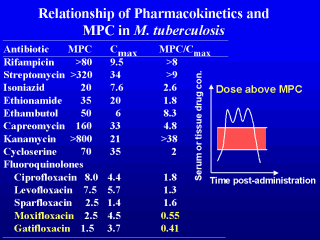 |
MPC measurements were obtained
with M. tuberculosis for many of the traditional anti-tuberculosis agents. In the
second column we list maximal serum concentrations taken from the literature (based on
recommended doses). In almost all cases MPC is above the maximal serum concentration
(ratio greater than 1), meaning that it is not possible to exceed MPC with these compounds
and this organism. These data provide the framework for the empirical observation that
anti-tuberculosis agents need to be used in combination to restrict the development of
resistance. Two compounds that have ratios below 1 are C-8-methoxy fluoroquinolones. These
data illustrate the special mutant-restricting property of moxifloxacin and gatifloxacin.
However, they should not be taken as meaning that the compounds are especially good
against tuberculosis, since the data do not address the ability of the compounds to kill
the organism. |
